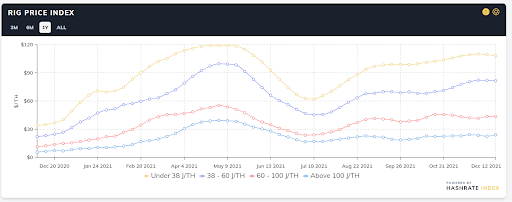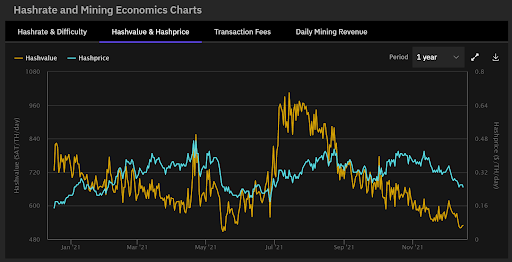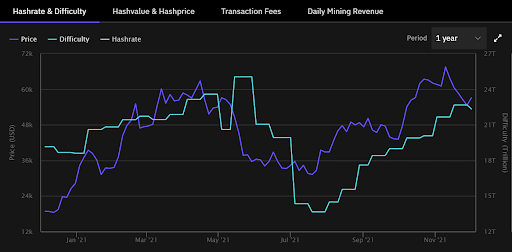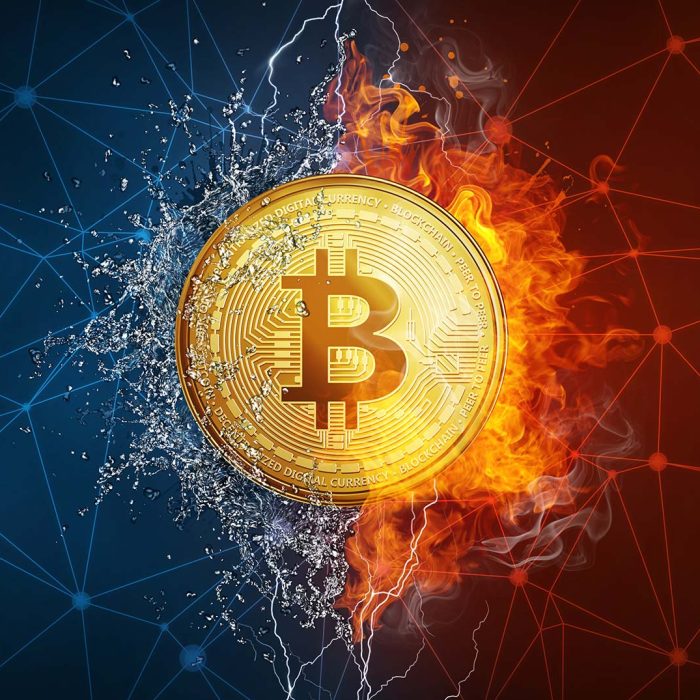Closely related to and dependent on hashvalue is hashprice. Hashprice is revenue generated by one terahash of hashrate in USD terms (Hashprice = $/TH/day). Multiplying hashvalue by BTC price gives you hashprice. ASIC pricing is largely determined by hashprice since it illustrates the value of the total BTC an ASIC can mine at a given difficulty, each day. To further understand this, let’s take a few examples.
First, let’s suppose the network difficulty were to increase 2x from 24T, but the price of BTC were to stay constant at $50K. Since hashvalue is more or less inversely proportional to difficulty (not accounting for transaction fees), Bitcoin miners would see their hashvalue get cut by 50%. Since BTC price has remained constant, the 50% drop in hashvalue ends up slicing our hasprice by 50% as well.
Next, let’s suppose that network difficulty were to increase 2x from 24T while the price of BTC climbed up 4x (as may be expected during a bull run). Even though our mining rigs will suffer a hahvalue drop of 50%, our hashprice is saved by the bull run and we see an increase of 100%.
Another example of this can be found in the chart above which shows BTC price and difficulty throughout 2021. You may ask, why didn’t hashprice double when hashvalue doubled in July? Despite the significant decrease in difficulty, the price of BTC also happened to drop by nearly 50% around the same time.
Now that we have a good understanding of some key components that impact ASIC pricing, let’s put it all together. ASIC prices are closely correlated with hashprice. This is because hashprice measures the value of the total Bitcoin an ASIC can mine at a given difficulty, each day. When hashprice goes up, it’s highly probable that ASIC prices will as well. The increase in hashprice means there is either a drop in difficulty, signaling an opportunity to mine more Bitcoin, or an increase in BTC price, making Bitcoin mining more worthwhile, or both.
As for difficulty, it’s only going to increase in the long-term (we anticipate 60-110%/year), but growth will be slow and steady compared to the volatile price action for BTC. This is mostly because factors like supply chain issues in ASIC manufacturing and the difficulty of building large scale mining infrastructure put a cap on the difficulty growth rate. However, as we know, the price of BTC can increase much much faster than 100%/year, especially in bull markets. With an ASIC supply chain bottleneck occurring in the midst of a bull market, hashprice will go up, and so will mining hardware prices.
All of these factors together spell higher ASIC prices in 2022. The good news is if you are bullish on BTC, then you should expect your Bitcoin mining machines to be appreciating assets. Especially when you consider they also generate discounted BTC cash flow since price continues to grow during the bull market.Also, with BTC mining hardware likely to increase in value in 2022, there’s a good case to be made for purchasing ASICs and generating discounted BTC from appreciating mining rigs rather than just buying spot BTC. This of course assumes you have a place to run a Bitcoin mining rig with decent electricity, like, for example, with our Managed Mining Program.








